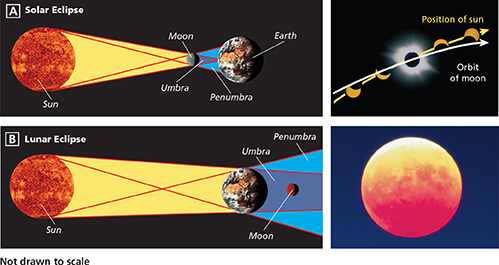Solar Eclipse
During a new moon, when the moon is between the sun and Earth, Earth may pass through the shadow of the moon.  A solar eclipse occurs when the moon casts a shadow on a portion of Earth's surface. As shown in Figure 9A, the moon casts two kinds of shadows on Earth during a solar eclipse. These two shadows occur because the sun is quite wide. It doesn't cast a sharp-edged shadow, as it would if it were a point of light. The small cone-shaped umbra (UM bruh) is the darkest part of the moon's shadow. Within the umbra, the sun's light is completely blocked by the moon. Only people in a very narrow path across Earth's surface are able to see a total solar eclipse. Surrounding the umbra is the larger penumbra (pih NUM bruh), a region of shadow that is less dark than the umbra. People within the penumbra see a partial solar eclipse.
A solar eclipse occurs when the moon casts a shadow on a portion of Earth's surface. As shown in Figure 9A, the moon casts two kinds of shadows on Earth during a solar eclipse. These two shadows occur because the sun is quite wide. It doesn't cast a sharp-edged shadow, as it would if it were a point of light. The small cone-shaped umbra (UM bruh) is the darkest part of the moon's shadow. Within the umbra, the sun's light is completely blocked by the moon. Only people in a very narrow path across Earth's surface are able to see a total solar eclipse. Surrounding the umbra is the larger penumbra (pih NUM bruh), a region of shadow that is less dark than the umbra. People within the penumbra see a partial solar eclipse.
Lunar Eclipse
During a full moon, when Earth is between the sun and moon, the moon may pass through Earth's shadow, as shown in Figure 9B.  A lunar eclipse occurs when Earth casts a shadow on the moon. Like the moon's shadow, Earth's shadow has an umbra and penumbra.
A lunar eclipse occurs when Earth casts a shadow on the moon. Like the moon's shadow, Earth's shadow has an umbra and penumbra.
If the moon passes completely into Earth's umbra, you see a total lunar eclipse. If instead of passing fully into Earth's umbra the moon passes partially through the umbra, you see a partial lunar eclipse.
Unlike a total solar eclipse, a total lunar eclipse can be seen from anywhere on Earth that the moon is visible. Thus, total lunar eclipses are much more frequently seen than total solar eclipses.
Figure 9 Eclipses occur only at the new moon or the full moon. A Solar eclipses occur at the new moon, when Earth can move through the moon's shadow. The multiple- exposure photo on the right has circles added to show several stages of a total solar eclipse. B Lunar eclipses occur at the full moon, when the moon can move through Earth's shadow. The moon has a reddish tint during a full lunar eclipse because some sunlight refracted by Earth's atmosphere reaches the moon.
Comparing and Contrasting Why are total lunar eclipses more frequently seen than total solar eclipses?






